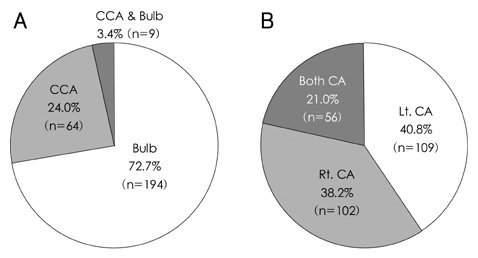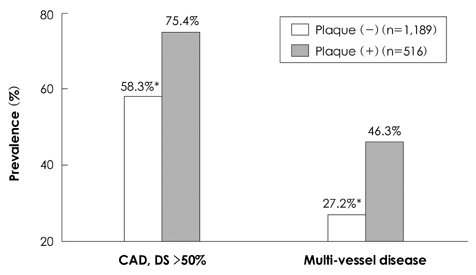Korean Circ J.
2009 Aug;39(8):317-321. 10.4070/kcj.2009.39.8.317.
Prevalence and Significance of Carotid Plaques in Patients With Coronary Atherosclerosis
- Affiliations
-
- 1Division of Cardiology, Heart Center, Konyang University Hospital, Daejeon, Korea. janghobae@yahoo.co.kr
- KMID: 2225681
- DOI: http://doi.org/10.4070/kcj.2009.39.8.317
Abstract
- BACKGROUND AND OBJECTIVES
Carotid artery intima-media thickness (CIMT) has recently been recommended as a non-invasive tool for primary prevention of cardiovascular events; the association between CIMT and adverse cardiovascular events is well-known. We sought to evaluate the prevalence and significance of carotid artery plaque, especially in patients with coronary atherosclerosis. SUBJECTS AND METHODS: The study population consisted of 1,705 consecutive patients {933 males (54.7%); mean age, 59.7+/-10.9 years} who underwent coronary angiography and carotid artery scanning using high-resolution ultrasonography. Carotid plaque was defined as a focal structure encroaching into the arterial lumen by at least 50% of the surrounding IMT value or a thickness >1.2 mm. RESULTS: Carotid plaque was identified in 30.3% (516/1,705) of the patients. Of patients in whom the plaque location could be evaluated (n=1,027), carotid plaque was located at the common carotid artery {n=64/267 (24.0%)}, carotid bulb {n=194/267 (72.7%)}, and at both sites {n=9/267 (3.4%)}. The prevalence of hypertension (58.5% vs. 45.2%, p<0.001) and diabetes mellitus (30.6% vs. 23.5%, p=0.007) was higher in patients with carotid plaques. The patients with carotid plaques were older (65.4+/-8.9 years vs. 57.2+/-10.7 years, p<0.0001), had a thicker CIMT (0.89+/-0.20 mm vs. 0.77+/-0.16 mm, p<0.001), and higher fasting blood sugar (FBS) levels (132.1+/-60.7 mg/dL vs. 121.6+/-47.1 mg/dL, p<0.001) than those without carotid plaque. Patients with carotid plaque more frequently presented with acute coronary syndrome (32.4% vs. 23.9%, p<0.001) than those without carotid plaque. Significant coronary artery stenosis by coronary angiography (75.4% vs. 58.3%, p<0.001), especially multi-vessel disease (46.3% vs. 27.2%, p<0.001), was more frequent in patients with carotid plaques. On multivariate analysis, old age (> or =65 years), hypertension, and increased CIMT (> or =1.0 mm) were independent predictors of carotid plaque. Carotid plaque (odds ratio, 1.85; 95% confidence interval, 1.39-2.45; p<0.001) was an independent predictor of multivessel disease based on multivariate regression analysis. CONCLUSION: Carotid plaque was common (30.3%) in Korean patients with coronary atherosclerosis, but it is still relatively uncommon compared to Western populations. Carotid plaque was associated with old age, hypertension, and increased IMT, and was an independent predictor of multi-vessel disease.
MeSH Terms
Figure
Reference
-
1. Stary HC. Evolution and progression of atherosclerotic lesions in coronary arteries of children and young adults. Arteriosclerosis. 1989. 9:1 Suppl. I19–I32.2. Tanaka H, Nishoino M, Ishida M, Fukunaga R, Sueyoshi K. Progression of carotid atherosclerosis in Japanese patients with coronary artery disease. Stroke. 1992. 23:946–951.3. Hodis HN, Mack WJ, LaBree L, et al. The role of carotid arterial intima-media thickness in predicting clinical coronary events. Ann Intern Med. 1998. 128:262–269.4. Bae JH, Seung KB, Jung HO, et al. Analysis of Korean carotid intima-media thickness in Korean healthy subjects and patients with risk factors: Korea multi-center epidemiological study. Korean Circ J. 2005. 35:513–524.5. Mannami T, Konishi M, Baba S, Nishi N, Terao A. Prevalence of asymptomatic carotid atherosclerotic lesions detected by high resolution ultrasonography and its relation to cardiovascular risk factors in the general popular of a Japanese city: the Suita study. Stroke. 1997. 28:518–525.6. O'Leary DH, Polak JF, Kronmal RA, et al. Thickening of the carotid wall: a marker for atherosclerosis in the elderly? Stroke. 1996. 27:224–231.7. Greenland P, Smith SC Jr, Grundy SM. Improving coronary heart disease risk assessment in asymptomatic people: role of traditional risk factors and noninvasive cardiovascular tests. Circulation. 2001. 104:1863–1867.8. Ebrahim S, Papacosta O, Whincup P, et al. Carotid plaque, intima media thickness, cardiovascular risk factors, and prevalent cardiovascular disease in men and women: the British Regional Heart Study. Stroke. 1999. 30:841–850.9. Cho DK, Kwon SU, Kim SW, et al. Risk factors and predictors for the progression of carotid atherosclerotic stenosis in Korean adults. Korean Circ J. 2005. 35:834–840.10. Fine-Edelstein JS, Wlf PA, O'Leary DH, et al. Precursors of extracranial carotid atherosclerosis in the Framingham Study. Neurology. 1994. 44:1046–1050.11. van der Meer I, Bots ML, Hofman A, del Sol AI, van der Kuip DA, Witteman JC. Predictive value of noninvasive measures of atherosclerosis for incident myocardial infarction: the Rotterdam Study. Circulation. 2004. 109:1089–1094.12. Stork S, van den Beld AW, von Schacky C, et al. Carotid artery plaque burden, stiffness, and mortality risk in elderly men: a prospective, population-based cohort study. Circulation. 2004. 110:344–348.13. Wattanakit K, Folsom AR, Chambless LE, Nieto FJ. Risk factors for cardiovascular event recurrence in the Atherosclerosis Risk in Communities (ARIC) study. Am Heart J. 2005. 149:606–612.14. Kim JH, Youn HJ, Hong SJ, et al. Clinical significance of B-mode ultrasound of common carotid artery for prediction of severity of coronary artery disease: important parameters on hand measurement. Korean Circ J. 2005. 35:467–473.15. Hallerstam S, Larsson PT, Zuber E, Rosfors S. Carotid atherosclerosis is correlated with extent and severity of coronary artery disease evaluated by myocardial perfusion scintigraphy. Angiology. 2004. 55:281–288.16. Prati P, Vanuzzo D, Casaroli M, et al. Prevalence and determinants of carotid atherosclerosis in a general population. Stroke. 1992. 23:1705–1711.17. Ebrahim S, Papacosta O, Lowe GD, et al. Carotid plaque, intima media thickness, cardiovascular risk factors, and prevalent cardiovascular disease in men and women: the British Regional Heart Study. Stroke. 1999. 30:841–850.18. Pujia A, Rubba P, Spencer MP. Prevalence of extracranial carotid disease detectable by echo-Doppler in an elderly population. Stroke. 1992. 23:818–822.19. Li R, Duncan BB, Metcalf PA, et al. B-mode-detected carotid artery palque in a general population. Stroke. 1994. 25:2377–2383.20. Frangos SG, Gahtan V, Sumpio B. Localization of atherosclerosis: role of hemodynamics. Arch Surg. 1999. 134:1142–1149.21. Fisher M, Fieman S. Geometric factors of the bifurcation in carotid atherogenesis. Stroke. 1990. 21:267–271.22. Zarins CK, Giddens DP, Bharadvaj BK, Sottiurai VS, Mabon RF, Glagov S. Carotid bifurcation atherosclerosis: quantitative correlation of plaque localization with flow velocity profiles and wall shear stress. Circ Res. 1983. 53:502–514.
- Full Text Links
- Actions
-
Cited
- CITED
-
- Close
- Share
- Similar articles
-
- Carotid ultrasound in patients with coronary artery disease
- Correlation between Intima-Media Thickness in Carotid Artery and the Extent of Coronary Atherosclerosis
- Relationship Between Carotid and Coronary Atherosclerosis in the Elderly
- Carotid Atherosclerosis as a Marker of Atherosclerosis of the Thoracic Aorta in the Elderly
- Prevalence of Carotid Atherosclerosis in the Elderly




